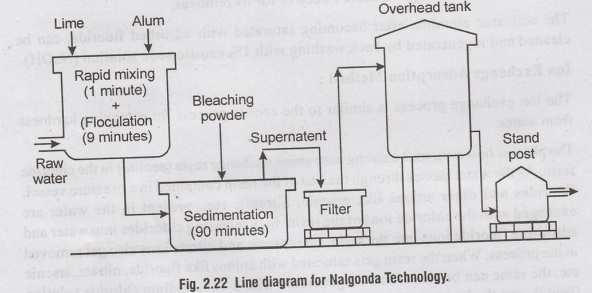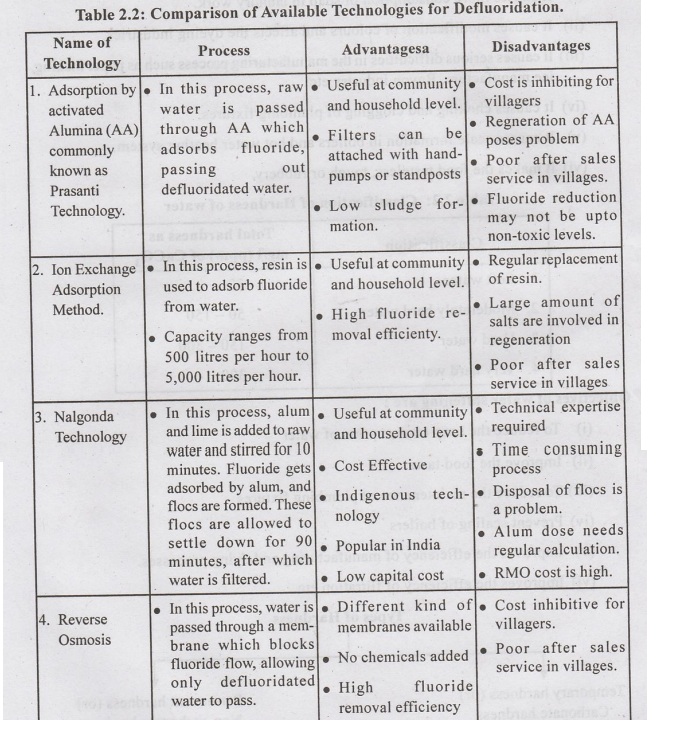Water Supply And Wastewater Engineering: Unit II: Water Treatment
Defluoridation
Methods or technologies | Water Treatment
The optimum concentration of fluoride in drinking water should be 1 to 1.5 mg/l; (preferably 1 mg/l), It is believed that fluoride deficienty in water causes dental caries (weaker tooth and enamel) in children. It is also believed that fluoride stimulates bone formation, reduces hardening of arteries and also helps in the treatment of osteoporosis.
DEFLUORIDATION
•
The optimum concentration of fluoride in drinking water should be 1 to 1.5
mg/l; (preferably 1 mg/l)
•
It is believed that fluoride deficienty in water causes dental caries (weaker
tooth and enamel) in children. It is also believed that fluoride stimulates
bone formation, reduces hardening of arteries and also helps in the treatment
of osteoporosis.
•
Due to this belief, if water is deficient in fluoride, fluoride compounds ar
added to water in the form of sodium fluoride (NaF), sodium Silico flourid
(Na2SiF6) and hydro-fluosilicic acid (H2SiF), and this process is calle
"Fluoridation".
However,
when the fluoride levels are in excess of 1 mg/l in water, it leads to th
following abnormalities:
(i)
Dental fluorosis - discoloured, blackened, mottled or chalky white teeth an
pitting of enamel.
(ii)
Skeletal fluorosis - Severe and permanent bone and joint deformations. (iii)
Non-skeletal fluorosis :
•
Gastro-intestinal problems (abdominal pain, diarrhoea, constipation)
•
Neurological disorders (nervousness,
excessive thirst, frequent urinatio Fluorosis can damage the foetus and also
adversely affect the IQ of childre Fluorosis is an irreversible disease and it
has no cure.
Therefore,
the excess fluoride has to be removed from water. The technique removal of
fluoride from water is known as "De-fluoridation".
Methods of
defluoridation:
The
following technologies are generally used for removing flourides from wat bos
(1) Absorption by Activated Alumina (AA),
commonly known as Prasa Technology;
(2)
Iron Exchange Adsorption method;
(3)
Nalgonda Technique; and
1. Prashanti
Technique using adsorption by activated alumina (AA).
In
this method, the raw water containing high contents of fluoride, is passed
(percolated) through the insoluble granular beds of substance like Activated
Alumina (AA), or Bone Char, or activated carbon, or serpentinite, or activated
bauxite; which we adsorbs fluoride from the percolating water, giving out
defluoridated water.
Activated
alumina, is found to be an excellent medium for removal of excess fluoride. It
is higly selective to fluoride in the presence of sulphates and chlorides, when
compared to synthetic ion exchange resins.
The
adsorption process is best carried out under slightly acidic conditions (pH =
5- 7); the lower value of pH is more effective for its removal.
The
activated alumina, after becoming saturated with adsorbed fluoride, can be
cleaned and regenerated by back washing with 1% caustic soda solution (NaOH).
2. Ion Exchange
Adsorption Method :
The
ion exchange process is similar to the zeolite process for removing hardness
from water.
The
process however, uses a strong base anion exchange resin (zeolite) in the
chloride form. As the water passes through the bed of the resin contained in a
pressure vessel, fluorides and other anions like arsenic, nitrates, etc.,
present in the water are exchaged with the chloride ions of the resin, thus
releasing chlorides into water and adsorbing fluoride ions into the resin. The
arsenic and nitrate ions also get removed in the process. When the resin gets
saturated with anions like fluoride, nitrate, arsenic etc. the same can be
cleaned and regenerated with 5-10% sodium chloride solution (brine), and the
bed is returned to service.
During
regeneration, the process gets reversed, as the anions absorbed on the resin
get replaced by chloride ions and discharged into waste water.
The
capacity of a plant based on this technology may range from 500 l/h to 5000 l/
h. The method ensures high efficiency of fluoride removal (besides removing
nitrates, arsenic, etc.) But it requires regular replacement of resin, and
large amount of salt (NaCl) for regeneration of resin. The method is very
costly and "after sales service" in villages is poor. The safe
disposal of waste water from regeneration, containing high concentrations of
toxic fluoride, nitrate and arsenic ions etc. again poses serious problems.
3. Nalgonda Technique
:
This
technique is widely used in Indian villages. This technique is simple and
economical than the ion-exchange processes, since it does not involve
regeneration of media, and employs chemicals which are readily available, and
easy to operate and maintain, using local skills. Nalgonda technique, not only
helps in the removal of fluoride, but also helps in removing colour, odour,
turbidity, bacteria and organic contaminants from raw supplies.
Nalgonda
technique uses aluminium salt (alum) for removing fluoride. The raw water is
firstly mixed with adequate amount of lime (CaO) or sodium carbonate abizo
(Na2CO3) and thoroughly mixed. Alum solution is then added, and water is
stirrred slowly for about 10 minutes, and allowed to settle for nearly one
hour. Th precipitated sludge is discarded, and the clear supernatant containing
permissibl amount of fluoride is withdrawn for use.

The
added lime or sodium carbonate helps to ensure adequate alkalinity requi for
effective hydrolysis of aluminium salts, so that the residual aluminium does
remain in the treated water. Bleaxching powder is also generally added with li
prior to the addition of alum, to achieve simultaneous disinfection of treated
wa L00 and also to keep the system free from undesirable biological growth.
4. Reverse Osmosis Process :-In this method, the raw water is passed through a s permeable membrane barrier,
which permits the flow of clear water through it and blocks the flow of salts
including fluorides. This method is generally adop for desalination for
removing salt from water and has been thoroughly explai under 'Desalination'.
This method is however rarely used solely for defluorida of village water
supplies due to prohibitive high cost and poor after sales servic machines
using such a treatment technology, although the method is capabl fficiency
without the use of any chemicals.
Choosing a particular
defluoridation method :
The
choice of technology depends upon the fluoride levels in water and the volume
of water to be fluoridated. The various merits -demerits of these technologies
are also kept in view, which is illustrated in Table.

Water Supply And Wastewater Engineering: Unit II: Water Treatment : Tag: : Methods or technologies | Water Treatment - Defluoridation
Related Topics
Related Subjects
Water Supply and Wastewater Engineering
CE3303 3rd Semester Civil Dept 2021 Regulation | Tag: 3rd Semester Civil Dept 2021 Regulation
